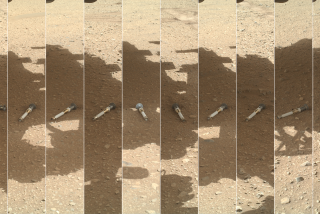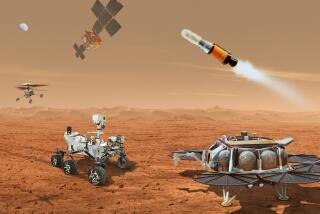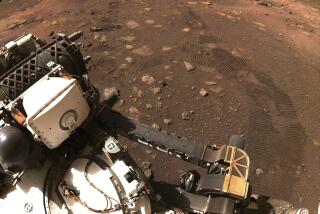Mars Observer Falls Silent at Crucial Point
- Share via
NASA engineers struggled furiously Sunday to regain communication with the Mars Observer after the $980-million space probe fell ominously silent when it was supposed to start pressurizing some fuel tanks in anticipation of arriving at the Red Planet.
The space agency’s Jet Propulsion Laboratory in Pasadena lost contact Saturday evening, 11 months after launch and less than 68 hours before the craft was scheduled to perform the mission’s most critical maneuver, insertion into Mars orbit.
JPL spokeswoman Diane Ainsworth said ground controllers on Friday afternoon had routinely transmitted to the spacecraft’s computer memory instructions for entering Mars orbit. She said the satellite is capable of performing the maneuver on its own.
However, even if placed in orbit, the craft would be useless to scientists if NASA engineers are unable to re-establish radio contact and receive data from the research instruments on board.
When the problem arose, engineers tried to coax the satellite to turn on its transmitter and point its antenna toward Earth by sending up commands every 20 minutes for 18 hours. That approach was fruitless.
Early Sunday afternoon, engineers tried to wring some sign of life from the craft by issuing a number of commands in series. They were unsure early Sunday evening whether this new approach had succeeded.
JPL workers were described as “tense but not gloomy” as they tried to sleuth out potential causes of the problem, which threatens a mission that many people in the National Aeronautics and Space Administration were counting on to restore luster to the agency’s tarnished image.
NASA engineers have overcome similar problems with the Mars Observer and other craft in the past, Ainsworth said. For example, communications interruptions with the Magellan probe to Venus a few years ago were corrected with new computer software.
Ground controllers also lost touch with the Mars Observer for more than an hour shortly after it was launched from Cape Canaveral, Fla., on a Titan III rocket in September. However, that problem was blamed not on the spacecraft but on faulty equipment aboard the booster rocket that pushed the 5,600-pound satellite out of Earth orbit toward Mars.
Although it is the most sophisticated planetary satellite ever lofted, Mars Observer also had been considered one of NASA’s most reliable craft because it was built out of components that had been extensively tested and flight-proven on other missions.
Beyond the damage that it could inflict on NASA, failure of the Mars Observer would be a profound disappointment to scientists around the world. An international team of researchers has been counting on the satellite to supply unprecedented amounts of information about the makeup of the Martian surface and the nature of its core. And it was designed to be the first alien-based weather channel, providing a full Martian year--687 Earth days--of daily weather reports from the Red Planet.
Dozens of less-sophisticated American and Russian probes dating back to the 1960s had established that Mars is cold, dry and--almost assuredly--dead. Mars Observer was designed to help scientists figure out if it had always been that way.
Weathering and erosion patterns on the planet’s boulder-strewn, volcano-pocked surface have teased geologists with the possibility that Mars once had enough water to form mighty rivers. This, in turn, suggests that it must have had an atmosphere far different from the wisps of carbon dioxide that now surround the planet.
Mars, in other words, once may have resembled ancient Earth. Scientists are eager to learn how closely the planets resembled one another and why they are so different today.
After a roundabout 450-million-mile route from Earth, Mars Observer was supposed to start easing into a 234-mile-high polar orbit Tuesday, then spend three months readying its battery of sophisticated instruments to answer some of those questions.
Researchers are particularly interested in learning more about how Mars works as an ecosystem--how weather and water have shaped its surface, how hurricane-force dust storms influence weather, whether Mars is geophysically active, and how volcanoes have affected the planet’s evolution.
And, perhaps most of all, they want to learn what happened to all the water that apparently carved deep channels into its spectacularly rugged landscape.
“We want to understand the early conditions on Mars and how it evolved and changed,” said Mars Observer project scientist Arden L. Albee. “Earth, Mars and Venus are all about the same size and (roughly) the same distance from the sun. How in the heck did they all wind up so different? We think there are lessons to be learned.”
The computer-packed space probe, about the size of a golf cart but as heavy as two Jeep Cherokees, is designed to help scientists answer such questions by sending more scientific data than all American planetary probes prior to the recent Magellan mission to Venus.
Before engineers lost contact with it, NASA officials had been praising the spacecraft for its flawless performance. Mars Observer project manager Glenn Cunningham said last week that the mission was proceeding so well that the probe would not even need its final mid-course correction in order to insert itself into Mars orbit.
That orbit-insertion procedure, which Cunningham described as “the most critical event in the mission,” involves guiding the spacecraft to hit the right spot in space at precisely the right speed so that Mars’ gravity pulls the satellite into orbit.
To start this process, Mars Observer is scheduled to fire rocket thrusters at 1:42 p.m. Tuesday to shave 1,600 m.p.h. off the satellite’s speed, reducing it to 10,200 m.p.h., while guiding it to a spot just over the north Martian pole.
Engineers lost communication with the spacecraft just as it was scheduled to automatically pressurize the fuel tanks that feed the thrusters.
At the same time, the spacecraft was adjusting its navigational gyroscopes; Ainsworth said engineers were investigating the possibility that the vibration caused by this may have caused a short circuit or otherwise contributed to the radio blackout.
Assuming engineers can find the problem and fix it, Mars Observer will give scientists their first glance at Mars since twin Viking landers in the 1970s sent back sensational photographs of a rocky red desert landscape that was at once familiar and eerie.
On Dec. 16, the probe is scheduled to turn all seven on-board instruments toward Mars to begin its intensive analysis of the planet’s geophysical processes. Each instrument would study part of the system in a different way:
* A gamma ray spectrometer will record how the surface reacts to the constant bombardment of cosmic rays. Each element--silicon, iron and uranium, for example--will reflect a distinctive kind of gamma ray back to the craft. Scientists analyzing these reflected rays can tell what the surface is made of.
* A thermal-emission spectrometer will analyze the infrared radiation emitted by the surface to determine how those elements are arranged into minerals. Each mineral, such as feldspar and granite, has a unique infrared “signature.” Arizona State University scientists have studied and catalogued the signatures of hundreds of Earth minerals for comparison.
* A line-scan camera will take thousands of snapshots each day to let atmospheric scientists study the Martian climate. It also will be able to make more detailed images of selected areas to study surface geology and erosion--and to take a close look at the two Viking lander sites and geologic features that some people believe may have been made by an ancient civilization.
* A laser altimeter will gather data for making a detailed three-dimensional topographic map of the entire planet.
* An infrared radiometer will work as the one-stop weather shop, measuring atmospheric dust, clouds, temperature, water vapor and visibility. By operating an entire year, it would describe for scientists how these factors change with the Martian seasons, describing the planet’s meteorological cycle.
* A magnetometer and electron reflectometer will measure and study the nature of the Martian magnetic field. Scientists will use the data to learn more about how this field interacts with the solar wind, the steady stream of radiation pouring off the sun.
* The satellite’s radio will be used to map the planet’s gravity. When the spacecraft flies over a particularly dense area, the additional gravity will slow it slightly; this is reflected in its radio signal and can be detected.
Data from these instruments also could be combined to study complex phenomena. Scientists can compare data from the two spectrometers to see how the elements on Mars combine to form minerals--a process that might reveal if some of the planet’s once-vast supply of water is locked up in its rocks. Adding weather data may tell how much water is hiding in polar ice.
The flood of information expected from these instruments amazes even the scientists working with them. The thermal-emission spectrometer is expected to send 100,000 spectra each day--more than 38 million over the life of the project.
Philip R. Christensen, the principal investigator for that device, said he and his Arizona State University colleagues have programmed a computer to compare three spectra a second with the catalogue of spectra for hundreds of Earth minerals they have laboriously compiled. Even at that rate, however, he said he could spend the rest of his career studying the data.
With the information, he can learn much more about what Mars is like. Scientists know that Mars appears red because of the abundance of iron oxides in its surface. Christensen said his spectrometer is designed to tell him whether the entire surface is rich in iron or whether iron is found only in a light sprinkling of dust over some other material.
Christensen added that he expects most of the minerals on Mars to be similar to those found on Earth and the moon. But his spectrometer is capable of finding some surprises, too.
“The beauty of geology is that you can combine elements in a lot of different ways,” said the Arizona State geology professor. “I fully expect we will find minerals on Mars that don’t exist on Earth.”
Mars has surprised scientists before, and they expect to be surprised again.
“From a distance, it doesn’t look like anything we recognize,” said Michael C. Malin, the principal investigator for the line-scan camera. “But the Viking landers showed us areas that look like a desert you might go four-wheeling on.”
Eventually, scientists hope to do just that. Russia plans to send a remote-controlled rover to Mars in this decade, giving scientists an opportunity to explore up-close several of the more interesting surface features.
Mars Observer will play a role in selecting the sites to be explored, scientists said. And, if it has not worn out its rechargeable batteries or otherwise broken down, the spacecraft could act as a radio relay to help transmit the rover’s findings back to Earth.
Mission to the Red Planet
Mars appears as a bright reddish-orange “star” in the night sky. Most of its landscape is a barren desert of red rocks and soil. The Mars Observer will study the planet’sgeology, geophysics and climate.
Astronomers in the 19th Century thought they observed canals on the planet’s surface, giving rise to theories of intelligent life there. The Mariner probes of the 1960s and ‘70s showed that these features were an optical illusion. In 1976, the Viking landers found no sign of life.
Giant Storms
The surface characteristics and geology of Mars have long fascinated scientists. Among the most intriguing are the giant dust hurricanes, which can engulf the planet. This is how the storms are believed to develop:
1. The sun partially melts the northern polar cap, thickening the atmosphere with carbon dioxide and water vapor.
2. A low-pressure system from the warming northern hemisphere collides with high pressure, bringing cold air from the south.
3. The collision generates high winds that lift dust high into the atmosphere.
4. Carbon dioxide and water vapor freeze upon entering the colder hemisphere, falling like snow on the southern polar cap. This process is reversed from south to north as the seasons change.
More about Mars
* Giant shield volcanoes, including Olympus Mons, which is 15 miles high.
* Enormous canyons, such as the Valles Marineris. It is up to 3,000 miles long, 125 miles across and one to four miles deep, dwarfing Earth’s Grand Canyon.
* Channels resembling dry riverbeds, some of them hundreds of miles long. They seem to have been formed by running water, which would suggest that Mars once had a thicker atmosphere and warmer climate.
The Spacecraft
Mars Observer, launched from Cape Canaveral in September, 1992, carries seven sensors that will map and observe the planet in much the same way satellites here map the Earth’s weather and surface minerals. The spacecraft will relay reports each day for at least one Martian year, 687 Earth days, from a low polar orbit.
Sources: Astronomy magazine, Sky & Telescope magazine, NASA, Jet Propulsion Laboratory, the International Encyclopedia of Astronomy, McGraw-Hill Encyclopedia of Astronomy.
More to Read
Sign up for Essential California
The most important California stories and recommendations in your inbox every morning.
You may occasionally receive promotional content from the Los Angeles Times.










